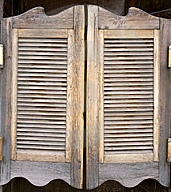saloon
Saloon has been a West American, slightly self-deprecating term for a bar or a motel since around 1800 from the originally French word salon , which has also been used in German since the 18th century (meaning the representative living room of the upper class and the nobility ). A saloon largely corresponds to the clichés from western films and wild west novels .
The local

Basically there were many, very different forms of appearance of the saloon. The simplest design was the tent saloon . This form was found especially in the times of the gold rush, when it came to building such an establishment overnight. Some were just a huge tent (comparable to today's beer tent ), others had a wooden house front and the tent behind it.
If a saloon was able to establish itself in a city, then mostly large wooden houses were built (as was usual for the time). The building equipment of a saloon usually included a connecting post / beam or stable for horses. (Exceptions were extensions , verandas , water troughs, etc.). In large and wealthy cities, saloons were also built from bricks (especially in the later 19th century).
The interior of a saloon could vary widely. Depending on the district (in larger cities), the variations ranged from simple, functional bars to lavishly furnished houses with one floor and an associated gallery. Often there were also dance stages with small "revues", as well as a piano or other instruments. The more elegant houses were often furnished in the European style, which was very popular at the time. These included heavy silk wallpaper on the wall, artfully decorated furniture, beer taps made of polished brass etc. In addition to the regular wooden doors, there were the famous saloon doors in warmer regions, two half-height, freely swinging wing doors (double spring hinges ) on the sides of the doorway. A central point was the counter of the saloon, which was usually very large and dominated the room. Often there was a huge mirror behind the counter (often in a fine frame). The lighting of the restaurants went from simple candles to kerosene lamps to gas light (in later epochs).
The importance
The saloon was a purely male domain and was considered a place of vice. Therefore, most of the women you met in a saloon were engaged in professional prostitution . Some saloons even offered their customers their own rooms that could be rented. The saloon was also a central point of gambling . Almost every self-respecting saloon had at least one gaming table, mostly a Faro bench. In the better houses there were also dice and roulette tables .
The audience was otherwise very mixed, depending on the reputation or location of a saloon , all social classes were represented , from middle-class men to soldiers and cowboys who earned their wages.
Nevertheless, the saloon was the social center of an average city at the time. It was usually the first port of call for people new to the city to get an overview of what was going on. Anyone who needed information or wanted to hear the latest gossip was in good hands in a saloon.
Variations / varieties
The saloon was basically a pure drinking eatery (comparable to a bar today ), food was rarely offered. Often there was an attached restaurant that had direct access to the saloon. In very small cities or towns, which often consisted of only a few houses, there were saloons that were also department stores , restaurants and post offices. Saloons in remote areas that came very close to a stagecoach station or trading post were even rarer. Sometimes these varieties even had a bathhouse attached.
The further south you went ( Texas , New Mexico ), the more the saloons adapted to the Mexican image and were often run under the name Cantina.
Another variation of the saloon is the honky tonk , the Afro-American version of a saloon in which the ragtime music styles have developed.
Saloons today
Basically, all saloons were places that were known for offering alcohol. So it was not surprising that many saloons closed with the beginning of Prohibition . Many of the saloons have been converted into cafes and casinos .
Classic saloons can still be found here and there in the southern United States and Mexico . One of the most famous saloons is the No. 10 in Deadwood , South Dakota . The gunslinger James Butler Hickok (Wild Bill) was once murdered in this saloon .
Famous names
Well-known personalities who have dealt with saloons include:
- Al Swearengen , co-founder of the town of Deadwood
- Scott Joplin , famous pianist, is considered to be the co-founder of ragtime
- Wyatt Earp , Marshall and saloon owners, e.g. B. of the Oriental in Tombstone , Arizona
literature
- Paul Trachtman: The Great Gunslingers . Marshals, sheriffs, outlaws. Men who became legends. Naumann & Göbel, Cologne 2002, ISBN 3-625-10761-9 .

